Dangers of Collars and Harnesses
Both dog collars and harnesses can cause injuries if not used properly, but wide collars and harnesses generally distribute pressure more evenly across more area and reduce the risk of injuries. Collars can lead to neck strain, trachea damage, and other issues if a dog pulls on the leash. Harnesses, especially those that attach at the back, can encourage pulling and potentially cause musculoskeletal issues if not fitted correctly. 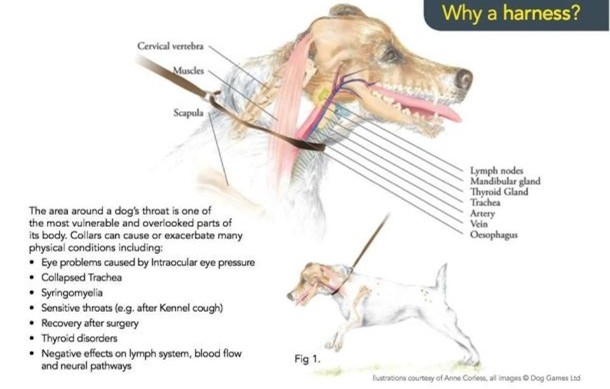
Collar Injuries:
Neck Injuries: Collars can cause neck strain, trachea damage, and even fractured vertebrae, especially when dogs pull on the leash.
Eye and Ear Problems: Jerking the leash can restrict blood flow to the eyes and ears, potentially causing swelling and long-term damage.
Nerve Damage: Collars can damage nerves in the front legs, causing tingling or paw licking.
Strangulation Hazards: Loose collars can get caught on objects or legs, leading to strangulation.
Harness Injuries:
Shoulder and Joint Issues: Ill-fitting harnesses can restrict movement, cause shoulder pain, arthritis, and affect gait.
Increased Pulling: Back-clip harnesses may encourage pulling, especially in dogs not accustomed to loose-leash walking.
Discomfort and Restricted Movement: Poorly fitted harnesses can cause chafing, pressure on the chest cavity, and restrict natural movement.
Choosing the Right Equipment:
Collars are great for holding ID tags and are suitable for dogs that walk politely on leash. Consider using a breakaway collar for added safety, especially during off-leash play or crating.
For dogs that pull or are still learning leash manners, a well-fitted harness can reduce pressure on the neck and offer better control. A harness should be properly fitted to avoid pressure points and allow for a full range of motion. Back-clip harnesses may not be ideal for all dogs and can encourage pulling.
Positive reinforcement and leash training are essential, regardless of whether a collar or harness is used.
Recommendations:
- Consult with a veterinarian or professional dog trainer: to determine the best walking equipment for your dog’s individual needs.
- Prioritize loose-leash walking: to prevent pulling and potential injury, regardless of the equipment used.
- Ensure proper fit and adjustability: when using either a collar or harness to prevent discomfort and injury.
Dog Harnesses
Fitting a harness properly on your dog is crucial for their comfort, safety, and to prevent injury. A well-fitted harness will distribute pressure evenly, preventing strain on their neck and throat, and reduce the likelihood of them wiggling out.
Before You Start (What You’ll Need):
- The Harness: Ensure you have the correct size range for your dog. Most harnesses have sizing charts based on chest girth and neck dog.
- Treats: To make the experience positive for your dog.
- A Relaxed Dog: Choose a time when your dog is calm and not overly excited.
Step-by-Step Guide (these steps generally apply to most dog harnesses, but specifics might vary slightly by harness type):
- Measure Your Dog (If You Haven’t Already):
- Neck Circumference: Measure around the widest part of your dog’s neck, where their collar would naturally sit.
- Chest Girth: This is the most critical measurement. Measure around the broadest part of your dog’s rib cage, just behind their front legs.
- Back Length (Optional but helpful for some harnesses): Measure from the base of their neck to the base of their tail.
- Compare these measurements to the harness manufacturer’s sizing chart. When in doubt, go for the larger size within a range if your dog is between sizes, as most harnesses are adjustable.
- Orient the Harness:
- Lay the harness out flat to identify the top, bottom, front, and back. Most harnesses will have a D-ring for leash attachment on the back (top) and buckles or clips on the sides or chest.
- Identify the neck opening and the chest strap.
- Put the Harness On:
- Over the Head: Gently slip the neck opening of the harness over your dog’s head. Make sure the D-ring (where the leash attaches) is positioned on their back, between their shoulder blades.
- Front Legs Through (if applicable): For some step-in or H-style harnesses, you might need to guide one or both front paws through designated leg loops. For Y-shaped or front-clip harnesses, the strap will go between their front legs.
- Secure the Straps: Bring the remaining straps around your dog’s chest and/or belly and fasten the buckles or clips. You should hear a clear click if it’s a buckle.
- Adjust the Straps (The “Two-Finger Rule”):
- Neck Strap: The neck strap should sit comfortably at the base of your dog’s neck, similar to a collar. You should be able to comfortably slide two finger widths between the strap and your dog’s neck. If you can fit more, it’s too loose; if you struggle to fit two, it’s too tight.
- Chest Strap (Girth Strap): This strap goes around your dog’s rib cage, just behind their front legs. Again, apply the two-finger rule. Ensure it’s snug but not constricting. It’s crucial that this strap is far enough back from the armpits to prevent chafing and rubbing, especially for active dogs. Aim for at least two fingers’ width behind the armpits.
- Front Chest Strap (if applicable): For Y-shaped or front-clip harnesses, there will be a strap that runs down the front of your dog’s chest, connecting the neck and girth straps. This should lie flat and centered. Adjust it so it doesn’t pull into their throat or restrict shoulder movement.
- Check for Movement and Comfort:
- No Gaps: There should be no large gaps anywhere that your dog could slip out of.
- Freedom of Movement: Your dog should be able to walk, run, and move their legs freely without the harness impeding their natural gait. Watch for any rubbing, especially in the armpit area.
- No Chafing: The straps should not rub or irritate their skin, particularly behind the front legs.
- Centered: The harness should remain relatively centered on your dog’s body as they move.
Test It Out:
- Take your dog for a short walk around the house or in the yard with the harness on.
- Observe how they move and react. Look for any signs of discomfort, rubbing, or if they are able to back out of the harness.
- Reward them with treats and praise for wearing the harness calmly.
Signs of a Poorly Fitted Harness:
- Chafing or Redness: Especially under the armpits or around the neck.
- Restricted Movement: Your dog seems to walk stiffly, hunches, or has an altered gait.
- Gagging or Coughing: If the neck strap is too tight or rides up.
- Rubbing of Hair: Excessive rubbing or matting of fur where the harness sits.
- Slipping Out: Your dog can back out of the harness or easily pull a leg out.
- Snagging: The harness material or buckles catch on their fur.
Maintenance:
- Regular Checks: Re-check the harness fit regularly, especially for growing puppies or if your dog’s weight changes.
- Cleanliness: Keep the harness clean to prevent skin irritation.
By following these steps, you can ensure your dog is comfortable and secure in their harness, making walks and training sessions more enjoyable and safer for both of you.
Click the image above to read more about leashes, harnesses and dangers associated with them by Dr. Peter Dobias, DVM.
Choosing the Right Harness for a Standard Poodle
Why structure matters—and how to fit it correctly
Not all dogs are built the same, and Standard Poodles have a unique combination of features that make choosing the right harness especially important. From their deep chest and narrow waist to their long neck and curly coat, the wrong harness can interfere with movement, mat the coat, or even create long-term orthopedic issues.
Why Harness Fit Matters for Poodles
Conformation Considerations
Standard Poodles are a well-balanced, square breed with: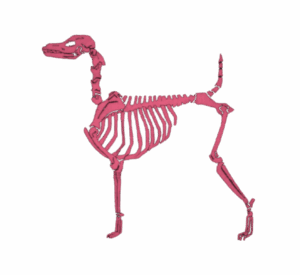
- A deep brisket (chest)
- High withers
- Long, arched neck
- Tight tuck-up (waist)
- Level topline and athletic build
Many generic harnesses do not account for this structure. A poorly designed or ill-fitting harness can:
- Rub against the shoulders or elbows, limiting range of motion
- Sit too low or high on the chest, affecting gait or breathing
- Pull unevenly, leading to poor posture over time
- Cause coat breakage or matting under the arms or along the spine
Choosing the Right Harness Style for Your Dog
Look for a harness that offers these features:
- Allows full shoulder extension
- Adjustable at multiple points (neck, chest, girth)
- Keeps pressure off the trachea
- Evenly distributes tension across the chest
⚠️ Avoid:
- “Easy step-in” harnesses – often rub the armpits and restrict leg movement
- Harnesses with horizontal chest straps – can limit reach and alter gait
- Head halters or overly restrictive models for young or sensitive dogs without proper introduction
This Y-style harness allows the dog full range of motion.
This “no-pull” style harness restricts the dog’s range of motion.
This “step-in” style harness restricts the dog’s range of motion.
How to Properly Fit and Use a Harness
Step 1: Adjust for Coat
If your Poodle is in full coat or a longer pet trim, adjust the harness to allow room without slippage. Always remove tangles and brush the coat beneath the straps to avoid matting.
Step 2: Position the Harness
- The front chest strap (in Y-harnesses) should sit above the point of the shoulder and rest along the prosternum—not across the throat.
- The girth strap should lie behind the elbow, not digging into it.
- The neck or shoulder straps should sit snugly but not press into the base of the neck.
If coat compression is creating hot spots or matting, a short sanitary trim beneath the straps may help.
Step 3: Check Fit
- You should be able to slide two fingers between the harness and the dog at all points.
- There should be no gaping or shifting when the dog moves.
- The harness should not restrict the dog’s natural gait at a walk or trot.
Training Tip:
If using a front-clip harness to reduce pulling, be sure to also train loose leash skills. Equipment should assist—not replace—positive reinforcement training.
Ideal Use Scenarios
Harnesses are great for:
- Puppies learning to walk on leash
- Adult dogs with sensitive necks
- Car safety (with a seatbelt tether)
- Active outings like hiking or travel
For show dogs or dogs in coat, rotate between flat collars and harnesses to minimize coat wear.
Harness Fit & Safety Checklist
Use this checklist every time you fit or adjust your puppy’s harness.
Proper Fit
- Two fingers fit snugly under all straps
- Harness does not press on the throat or neck
- Girth strap rests behind the elbows, not on top of them
- Front strap lies flat across the sternum, not the shoulders
- Harness stays centered and balanced—doesn’t twist or shift
- Puppy can move freely at a walk and trot
- Puppy is comfortable being harnessed
Coat & Skin Check
- No matting or tangles under straps
- No rubbing or hair breakage at contact points
- No red spots, irritation, or sores under armpits or chest
- Coat brushed out under harness after each use (especially in longer trims)
Safety Watchouts
- Harness is secure—puppy cannot back out or wiggle free
- No slipping when leash pressure is applied
- Puppy is not trying to bite, roll, or escape the harness
- Puppy shows no signs of stress or fear related to wearing it
Behavioral Green Flags
- Puppy is eager to go for walks and doesn’t avoid the harness
- No sudden changes in stride, posture, or pace when harnessed
- No signs of resistance (balking, stiffening, flattening ears) during harnessing
Tip: Check fit weekly—especially for growing puppies! A harness that fit last month may now be too tight or restrictive.
Choosing the right harness for your Standard Poodle is about more than convenience—it’s about honoring their structure, movement, and comfort. A well-fitted, appropriate harness supports healthy development, protects the coat, and makes daily walks more enjoyable and secure.
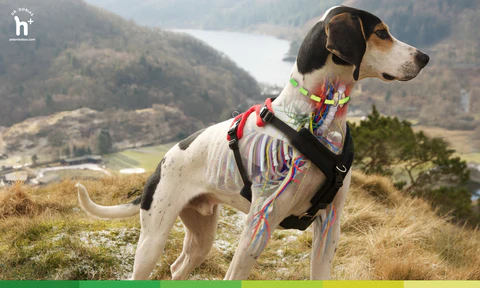
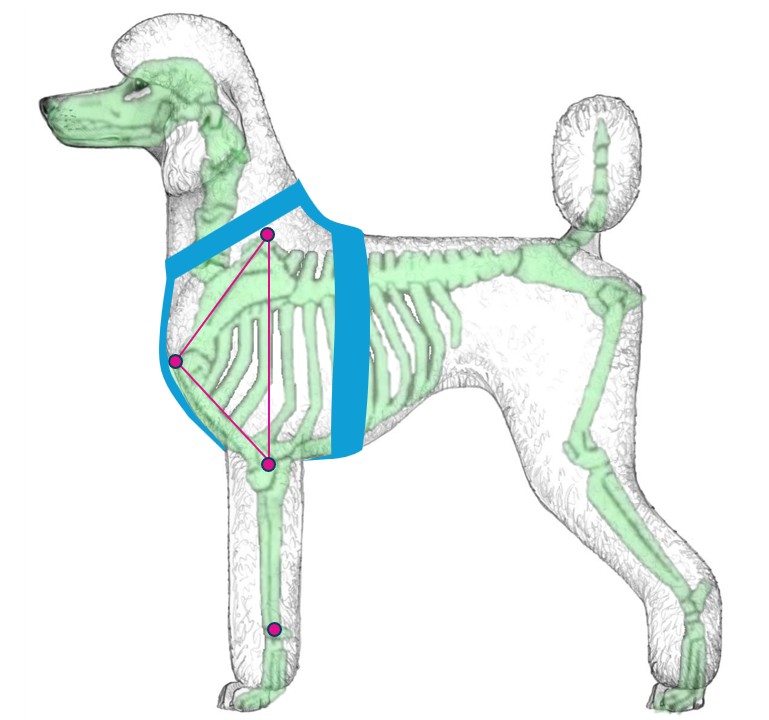
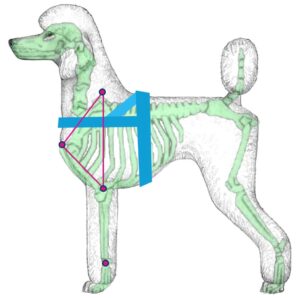
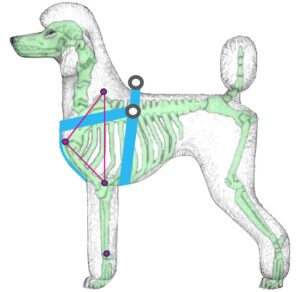
Recent Comments